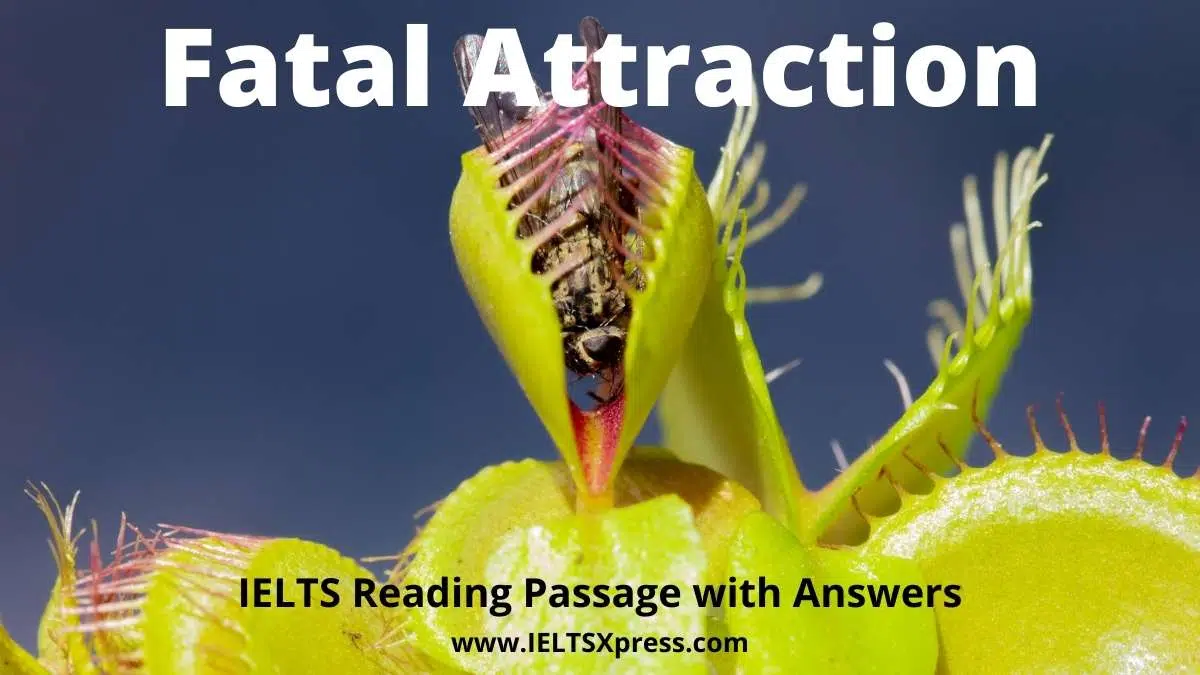Fatal Attraction IELTS Reading Passage with Answers
Reading Passage 2
You should spend about 20 minutes on Questions 1-13 which are based on Reading Passage 1 below.
Fatal Attraction
Evolutionist Charles Darwin first marveled at flesh-eating plants in the mid-19th century. Today, biologists, using 21st-century tools to study cells and DNA, are beginning to understand how these plants hunt, eat and digest – and how such bizarre adaptations arose in the first place.
A
The leaves of the Venus flytrap plant are covered in hairs. When an insect brushes against them, this triggers a tiny electric charge, which travels down tunnels in the leaf and opens up pores in the leaf’s cell membranes. Water surges from the cells on the inside of the leaf to those on the outside, causing the leaf to rapidly flip in shape from convex to concave, like a soft contact lens. As the leaves flip, they snap together, trapping the insect in their sharp-toothed jaws.
B
The bladderwort has an equally sophisticated way of setting its underwater trap. It pumps water out of tiny bag-like bladders, making a vacuum inside. When small creatures swim past, they bend the hairs on the bladder, causing a flap to open. The low pressure sucks water in, carrying the animal along with it. In one five-hundredth of a second, the door swings shut again. The Drosera sundew, meanwhile, has a thick, sweet liquid oozing from its leaves, which first attracts insects, then holds them fast before the leaves snap shut. Pitcher plants use yet another strategy, growing long tube-shaped leaves to imprison their prey. Raffles’ pitcher plant, from the jungles of Borneo, produces nectar that both lures insects and forms a slick surface on which they can’t get a grip. Insects that land on the rim of the pitcher slide on the liquid and tumble in.
C
Many carnivorous plants secrete enzymes to penetrate the hard exoskeleton of insects so they can absorb nutrients from inside their prey. But the purple pitcher plant, which lives in bogs and infertile sandy soils in North America, enlists other organisms to process its food. It is home to an intricate food web of mosquito larvae, midges and bacteria, many of which can survive only in this unique habitat. These animals shred the prey that fall into the pitcher, and the smaller organisms feed on the debris. Finally, the plant absorbs the nutrients released. ieltsxpress.com
D
While such plants clearly thrive on being carnivorous, the benefits of eating flesh are not the ones you might expect. Carnivorous animals such as ourselves use the carbon in protein and the fat in meat to build muscles and store energy. Carnivorous plants instead draw nitrogen, phosphorus, and other critical nutrients from their prey in order to build light-harvesting enzymes. Eating animals, in other words, lets carnivorous plants do what all plants do: carry out photosynthesis, that is, grow by harnessing energy directly from the sun.
E
Carnivorous plants are, in fact, very inefficient at converting sunlight into tissue. This is because of all the energy they expend to make the equipment to catch animals – the enzymes, the pumps, and so on. A pitcher or a flytrap cannot carry out much photosynthesis because, unlike plants with ordinary leaves, they do not have flat solar panels that can grab lots of sunlight. There are, however, some special conditions in which the benefits of being carnivorous do outweigh the costs. The poor soil of bogs, for example, offers little nitrogen and phosphorus, so carnivorous plants enjoy an advantage over plants that obtain these nutrients by more conventional means. Bogs are also flooded with sunshine, so even an inefficient carnivorous plant can photosynthesise enough light to survive. I E LT S X PRE SS.COM
F
Evolution has repeatedly made this trade-off. By comparing the DNA of carnivorous plants with other species, scientists have found that they evolved independently on at least six separate occasions. Some carnivorous plants that look nearly identical turn out to be only distantly related. The two kinds of pitcher plants – the tropical genus Nepenthes and the North American Sarracenia – have, surprisingly, evolved from different ancestors, although both grow deep pitchershaped leaves and employ the same strategy for capturing prey. IELTSXpress
G
In several cases, scientists can see how complex carnivorous plants evolved from simpler ones. Venus flytraps, for example, share an ancestor with Portuguese sundews, which only catch prey passively, via ‘flypaper’ glands on their stems. They share a more recent ancestor with Drosera sundews, which can also curl their leaves over their prey. Venus flytraps appear to have evolved an even more elaborate version of this kind of trap, complete with jaw-like leaves.
H
Unfortunately, the adaptations that enable carnivorous plants to thrive in marginal habitats also make them exquisitely sensitive. Agricultural run-off and pollution from power plants are adding extra nitrogen to many bogs in North America. Carnivorous plants are so finely tuned to low levels of nitrogen that this extra fertilizer is overloading their systems, and they eventually burn themselves out and die.
Humans also threaten carnivorous plants in other ways. The black market trade in exotic carnivorous plants is so vigorous now that botanists are keeping the location of some rare species a secret. But even if the poaching of carnivorous plants can be halted, they will continue to suffer from other assaults. In the pine savannah of North Carolina, the increasing suppression of fires is allowing other plants to grow too quickly and outcompete the flytraps in their native environment. Good news, perhaps, for flies. But a loss for all who, like Darwin, delight in the sheer inventiveness of evolution.
Questions 14-18
Complete the notes below.
Choose NO MORE THAN TWO WORDS from the passage for each answer.
How a Venus flytrap traps an insect
Insect touches 14 _________ on leaf of plant
Small 15 _________ passes through leaf
16 _________ in cell membrane open
Outside cells of leaves fill with 17 _________
Leaves change so that they have a 18 _________ shape and snap nut
Questions 19-22
Look at the following statements (Questions 19-22) and the list of plants.
Match each statement with the correct plant, A. B. C, D or E. Write the correct letter, A, B, C, D or E, in boxes 19-22 on your answer sheet.
19 It uses other creatures to help it digest insects
20 It produces a slippery substance to make insects fall inside it.
21 It creates an empty space into which insects are sucked.
22 It produces a sticky substance which traps insects on its surface.
List of plants
A Venus flytrap
B bladderwort
C Drosera sundew
D Raffles’ pitcher plant
E purple pitcher plant
Questions 23-26
Reading Passage 2 has nine paragraphs, A-l.
Which paragraph contains the following information?
23 a mention of a disadvantage of the leaf shape of some carnivorous plants
24 an example of an effort made to protect carnivorous plants
25 unexpected information about the origins of certain carnivorous plants
26 an example of environmental changes that shorten the life cycles of carnivorous plants
Fatal Attraction IELTS Reading Answers
14. hairs
15. (electric) charge
16. pores
17. water
18. concave
19. E
20. D
21. B
22. C
23. E
24. I
25. F
26. H
Also Check: The Study of Chimpanzee Culture IELTS Reading Answers




